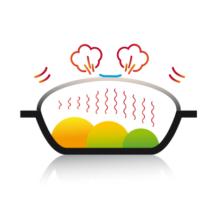We offer an integrated system designed for in-pack cooking and pasteurisation of ready meals.
We at Micvac are here to help you put a new and improved product on the market by providing the necessary know-how and technology. The patented Micvac system can be divided into two main parts:
- The packaging design – a special combination of materials and design, plus a particularly clever little valve, working together to enable in-pack cooking and pasteurisation.
- The food preparation line – where the trays are filled with fresh ingredients, cooked, pasteurised and chilled in one smooth, continuous process.
The easiest way to get a grasp of the method is to watch this video.
A better way to produce chilled ready meals
The Micvac method offers a new and better way to produce chilled ready meals. This is how it works.
The basic principle is in pack cooking and pasteurisation in one continuous process.
Fill with fresh ingredients
The first step is to fill the trays with fresh ingredients according to your recipe. This can be done by hand or in an automated process.
Apply valve and seal
When the ingredients are in place, it’s time to seal the tray. First a tiny hole is punched into the film. The Micvac valve is applied on top of the hole. The valve is actually the core of the Micvac innovation. We’ll come back to that in a bit.
Finally the film, with the valve, is firmly sealed to the rim of the tray.
Cook and release steam
Now we’re ready to cook. The packages are transported into the microwave tunnel. Depending on the recipe, they will spend 5-10 min in the tunnel. Thanks’ to the fast pasteurisation process more vitamins, colour and texture is preserved.
As the food starts to cook, the pressure rises inside the pack. This is when the Micvac valve makes its first contribution. At a specific pressure point the valve opens to release steam – and with it the oxygen molecules.
When temperature and pressure decreases, the valve closes shut. The remaining steam condenses causing underpressure in the package. A natural vacuum is established. Temperature control is essential for quality. We don’t want our ingredients to stew any longer than necessary.
Chill and apply sleeve
It’s time to cool down. The Micvac tray has a flexible bottom designed to cave in with the underpressure, thus giving the packages a concave shape that speeds up the cooling process.
Out comes a cooked, pasteurised and vacuum packed product with excellent taste and a shelf life way beyond other chilled ready meals – without the use of any preservatives!
Just wrap it up in a nice sleeve, and you’re ready to hit the stores.
The Micvac method in four steps

1. Fill the tray
The ingredients are put in the tray, either by machine or by hand.

2. Apply valve and film
The film and valve are applied in an automated process.

3. Cook and pasteurise
The now sealed package is cooked and pasteurised in a microwave tunnel. During pasteurisation the valve opens to let out steam, and with it all oxygen. The valve closes and a vacuum is created.

4. Cool down
The pasteurised and vacuumised meal moves on into a cooling unit, and now the fresh-made meals are ready for the store shelves.

Example: Dry pasta + Raw chicken + Fresh veggies + Warm sauce
- Portion cooked and in-pack cooking.
- Short, gentle cooking and pasteurisation.
- Short total production time.

